
Corymbia haematoxylon, commonly known as mountain marri, is a species of tree that is endemic to the south-west of Western Australia. It has rough, tessellated bark on the trunk and branches, lance-shaped to narrow egg-shaped adult leaves, flower buds in groups of seven, white flowers and urn-shaped fruit.
Corymbia greeniana is a species of tree that is endemic to northern Australia. It has rough bark on some or all of the trunk and larger branches, smooth bark above, broadly lance-shaped to egg-shaped adult leaves, flower buds usually in groups of seven, creamy white flowers and urn-shaped fruit with a distinct neck.
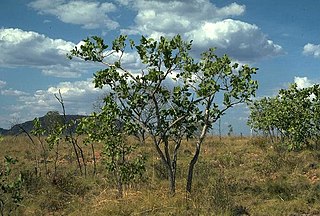
Corymbia abbreviata, also known as scraggy bloodwood, is a species of straggly tree that is native to Western Australia and the Northern Territory. It has rough bark, a crown of stiff leaves arranged in opposite pairs, flower buds usually in crowded groups on the ends of branchlets and urn-shaped fruit.

Corymbia arenaria, commonly known as bundah bundah or black bloodwood, is a species of tree that is endemic to the northern Kimberley region of Western Australia. It has rough bark on the trunk and branches, lance-shaped to curved adult leaves, flower buds in groups of seven, white flower and spherical urn-shaped fruit.

Corymbia bleeseri, commonly known as glossy-leaved bloodwood or smooth-stemmed bloodwood, is a species of tree that is endemic to northern Australia. It has thin, rough bark on part or all of the trunk, smooth bark above, lance-shaped to curved adult leaves, flower buds in groups of seven, creamy white flowers and barrel-shaped fruit.

Corymbia eremaea, commonly known as mallee bloodwood, hill bloodwood and Centre Range bloodwood, is a small, mallee-like tree that is endemic to central Australia. Indigenous Australians know the plant as muur-muurpa. It has rough, evenly tessellated bark, lance-shaped leaves, oval to pear-shaped flower buds arranged on a branching peduncle and urn-shaped fruit.

Corymbia erythrophloia, commonly known as red bloodwood, variable-barked bloodwood, red-barked bloodwood or gum-topped bloodwood, is a species of tree that is endemic to Queensland. It has rough bark on the trunk and branches, egg-shaped or lance-shaped adult leaves, flower buds in groups of seven, creamy white flowers and urn-shaped to spherical fruit.
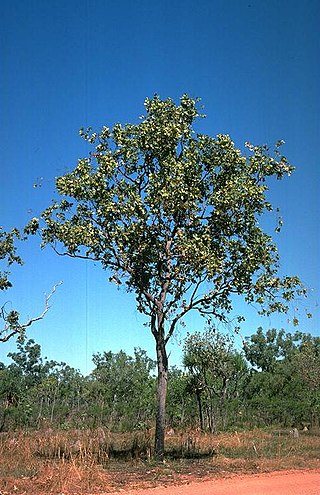
Corymbia ferruginea, commonly known as rusty bloodwood, is a species of tree that is endemic to northern Australia. It has rough, tessellated bark on the trunk and branches, a crown of sessile juvenile leaves, flower buds in groups of three or seven, pale creamy yellow flowers and urn-shaped fruit.

Corymbia foelscheana, commonly known as broad-leaved bloodwood, fan-leaved bloodwood or smooth-barked bloodwood, is a species of small tree that is endemic to northern Australia. It has thin, rough, tessellated bark on some or all of the trunk, smooth bark above, broadly egg-shaped to broadly lance- shaped adult leaves, flower buds usually in groups of seven, creamy white flowers and urn-shaped fruit.
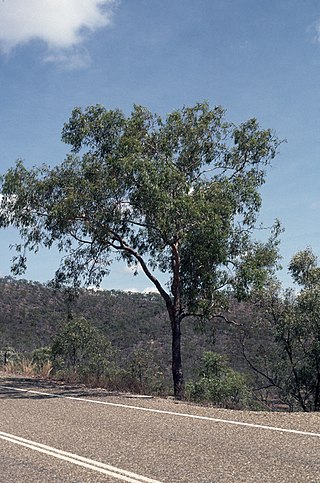
Corymbia hylandii, commonly known as Hyland's bloodwood, is a species of small tree that is endemic to part of the Cape York Peninsula. It has rough, tessellated bark on the trunk and branches, lance-shaped adult leaves, flower buds in groups of seven, creamy white flowers and urn-shaped fruit.
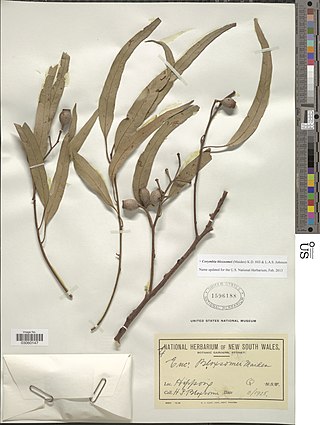
Corymbia bloxsomei, commonly known as yellowjack, yellow jacket or yellow bloodwood, is a species of tree that is endemic to inland, south-eastern Queensland. It has thick, rough scaly bark on the trunk and larger branches, lance-shaped or curved adult leaves, flower buds in groups of seven, nine or eleven, creamy white to pale yellow flowers and barrel-shaped, urn-shaped or spherical fruit.
Corymbia lamprophylla, commonly known as shiny-leaved bloodwood, is a species of tree that is endemic to central Queensland. It has rough, tessellated bark on the trunk and larger branches, lance-shaped adult leaves, flower buds in groups of seven, creamy white flowers and urn-shaped fruit.

Corymbia latifolia, commonly known as round-leaved bloodwood, round leaf bloodwood, wubam and other names in indigenous languages, is a species of tree that is endemic to northern Australia. It has thin, rough bark over part or all of the trunk, smooth bark above, triangular or broadly egg-shaped adult leaves, flower buds in groups of seven, creamy white flowers and urn-shaped fruit.
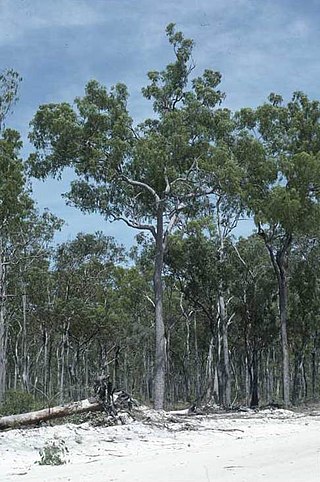
Corymbia nesophila, commonly known as Melville Island bloodwood, is a species of tree that is endemic to northern Australia. It has rough, tessellated bark on the trunk and branches, lance-shaped or curved adult leaves, flower buds in groups of seven, creamy white flowers and urn-shaped fruit.
Corymbia petalophylla is a species of tree that is endemic to Queensland. It has rough, tessellated bark on the trunk and branches, lance-shaped or curved adult leaves, flower buds in groups of seven, white flowers and barrel-shaped, urn-shaped or shortened spherical fruit.
Corymbia polysciada, commonly known as apple gum, paper-fruited bloodwood or bolomin, is a species of tree that is endemic to the Top End of the Northern Territory. It has rough, tessellated bark on some or all or the trunk, smooth bark above, egg-shaped to broadly lance-shaped adult leaves, flower buds in groups of seven, creamy white flowers and cup-shaped, cylindrical or barrel-shaped from on long pedicels.

Corymbia umbonata, commonly known as rusty bloodwood, is a species of tree that is endemic to the Top End of the Northern Territory. It has thin, rough bark on the trunk, often also the branches, lance-shaped or curved adult leaves, flower buds in groups of seven, creamy white flowers and urn-shaped fruit.

Corymbia watsoniana, commonly known as large-fruited yellowjacket, is a species of tree that is endemic to Queensland. It has rough, tessellated bark on the trunk and branches, egg-shaped to broadly lance-shaped adult leaves, flower buds in groups of seven, creamy white flowers and barrel-shaped or urn-shaped fruit.
Corymbia xanthope, commonly known as Glen Geddes bloodwood, is a species of tree that is endemic to a small area of Queensland. It has thick, rough bark on the trunk and branches with yellow bark visible underneath, lance-shaped to curved adult leaves, flower buds in groups of seven, creamy white flowers and urn-shaped fruit.
Corymbia novoguinensis is a species of tree that is native to New Guinea, some Torres Strait Island and the Cape York Peninsula. It has rough bark on the trunk and branches, lance-shaped adult leaves, flower buds in groups of seven, creamy white flowers and urn-shaped to barrel-shaped fruit.













